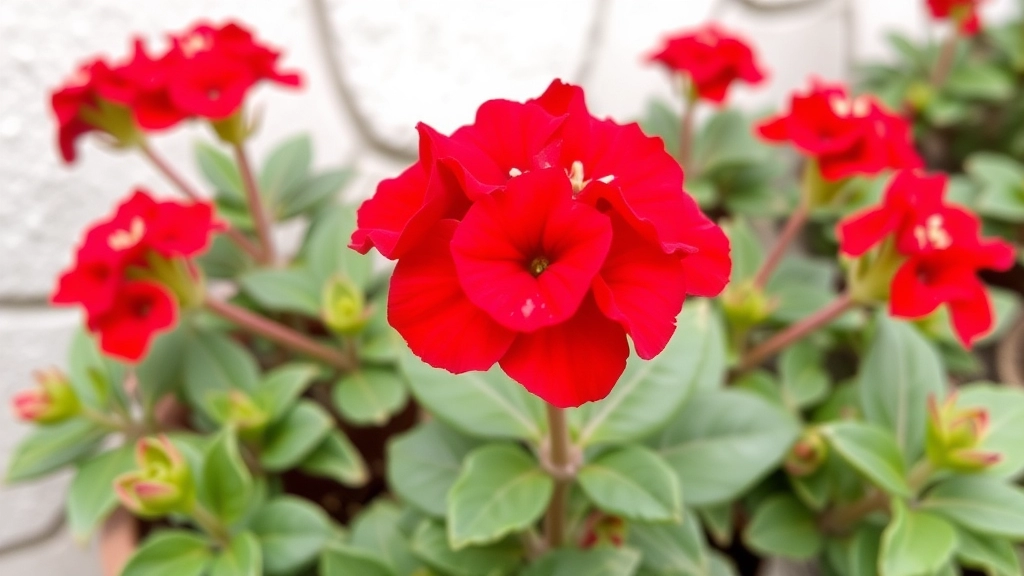Guide to Caring for the Florist Kalanchoe Red
Looking to add a splash of vibrant red to your indoor garden? The Florist Kalanchoe Red is a perfect choice. This guide will walk you through everything you need to know about caring for this stunning plant, from choosing the right soil to encouraging reblooming. Let’s dive in and make your Kalanchoe blossfeldiana thrive.
Soil Selection
First off, picking the right soil is crucial. Kalanchoe Red loves well-draining soil to prevent root rot.
Light Requirements
Next, place your plant in a spot with plenty of indirect sunlight.
Watering Techniques
Proper watering techniques are essential; let the soil dry out between waterings.
Temperature Preferences
Keep an eye on the temperature, as these succulents prefer a warm environment.
Conclusion
With these tips, your Kalanchoe Red will flourish and brighten up any space.
Choosing the Right Soil for Kalanchoe Red
When it comes to growing Kalanchoe Red, one of the most pressing questions is: what type of soil should I use? The right soil is crucial for the health and vibrancy of your plant.
Key Considerations for Soil Selection
- Well-Draining Mix: Kalanchoe requires soil that drains well to prevent root rot. A cactus or succulent potting mix is often ideal.
- pH Level: Aim for a slightly acidic to neutral pH, ideally between 6.0 and 7.0. This range supports optimal nutrient uptake.
- Organic Matter: Incorporating organic matter, such as compost, can enhance soil fertility and moisture retention without compromising drainage.
- Additives: Consider adding perlite or sand to improve aeration and drainage. This helps create a balanced environment for root growth.
Example of a Soil Mix
You might find it helpful to create your own soil mix using the following components:
- 50% cactus or succulent potting mix
- 25% perlite
- 25% coarse sand
Using this mix can significantly improve your Kalanchoe’s health and blooming potential. For more detailed care tips, you can refer to our Kalanchoe Paddle Plant Care Guide and explore other Top Flowering Kalanchoe Species and Care Tips.
Ideal Light Conditions for Florist Kalanchoe
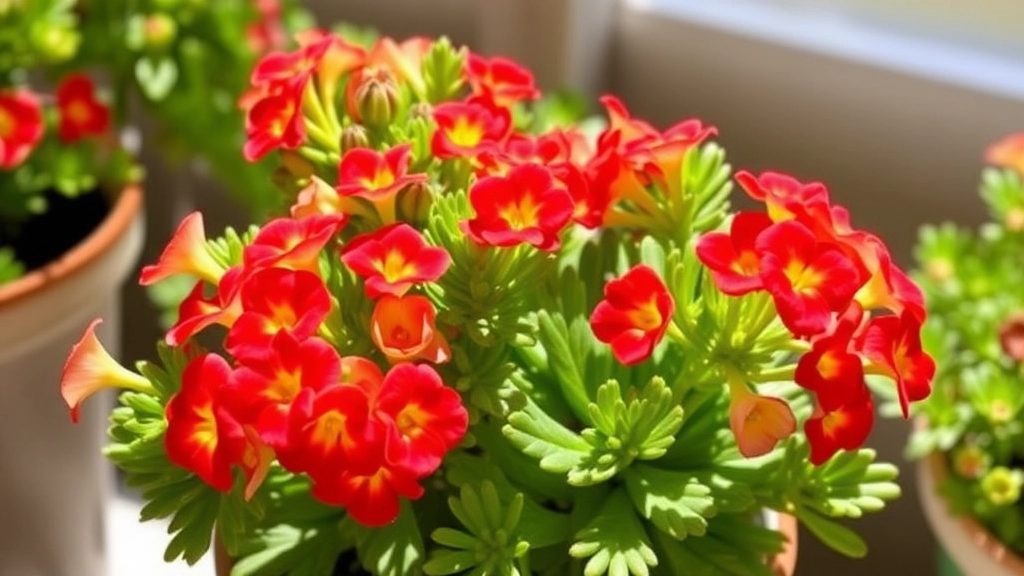
So, you’ve got your Kalanchoe Red, and you’re wondering, “What’s the best light for my little beauty?”
Let’s dive into the light conditions that will help your Florist Kalanchoe thrive.
These plants are pretty straightforward when it comes to lighting. They love bright, indirect sunlight.
Key Points for Light Conditions:
- Direct Sunlight: Too much can scorch the leaves. Aim for about 6 hours of bright, indirect light daily.
- Window Placement: A south or east-facing window is often ideal. If it’s too harsh, you can use sheer curtains to filter the light.
- Signs of Insufficient Light: If your Kalanchoe starts stretching or looking leggy, it’s a sign it’s not getting enough light.
- Signs of Too Much Light: Yellowing leaves or burnt tips? That’s your cue to move it to a shadier spot.
- Rotation: Don’t forget to rotate your plant every so often. This helps it grow evenly and prevents it from leaning toward the light.
In short, your Kalanchoe will thrive in a well-lit spot where it can soak up that lovely indirect sunlight.
Proper Watering Techniques for Succulents
Many plant enthusiasts often wonder: how do I properly water my Kalanchoe Red? Overwatering is a common concern, especially for succulents, which thrive in drier conditions.
Understanding the Needs of Kalanchoe
Kalanchoe, like many succulents, stores water in its leaves. This adaptation allows it to survive in arid environments. Here are some essential watering tips to keep your Kalanchoe Red healthy:
- Check the Soil: Always ensure the top inch of soil is dry before watering. This prevents root rot.
- Water Deeply: When you do water, do so thoroughly. Ensure water drains out of the pot’s bottom.
- Frequency: During the growing season (spring and summer), water every 1-2 weeks. In winter, reduce to once a month.
- Use Room Temperature Water: Cold water can shock the plant. Room temperature water is ideal.
- Avoid Water on Leaves: Watering directly on the leaves can lead to fungal issues. Focus on the soil.
Signs of Overwatering
Recognising the signs of overwatering is crucial. Look out for:
- Yellowing leaves
- Mushy stems
- A foul smell from the soil
These symptoms indicate that you need to adjust your watering routine. For more detailed care instructions, you can refer to our ultimate guide on caring for Kalanchoe succulents. Additionally, if you are interested in specific care tips for different varieties, check out this guide on Kalanchoe Paddle Plant care.
Best Temperatures for Growing Kalanchoe Blossfeldiana
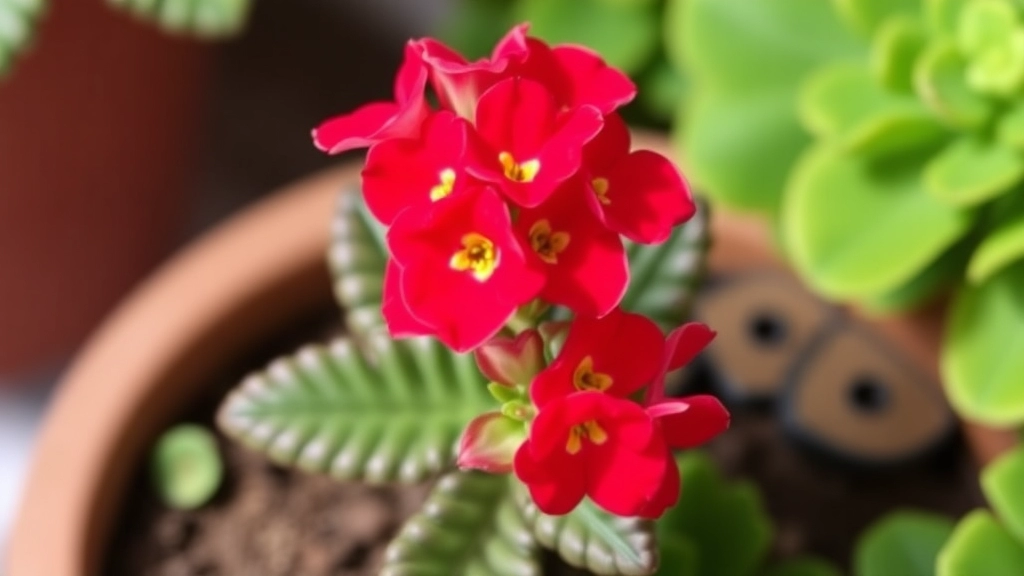
When it comes to nurturing your Kalanchoe Blossfeldiana, temperature plays a crucial role in its growth and blooming potential. You might be wondering, “What temperature does my Kalanchoe need to thrive?”
Ideal Temperature Range
Kalanchoe prefers a comfortable environment, ideally between 18°C to 24°C (65°F to 75°F).
- Daytime temperatures: Aim for the upper end of this range.
- Nighttime temperatures: A slight drop to around 15°C to 18°C (59°F to 65°F) is beneficial.
Temperature Extremes to Avoid
- Cold drafts: Keep your plant away from chilly windows or doors.
- Heat sources: Avoid placing it near radiators or heating vents.
Seasonal Considerations
- Winter care: As temperatures drop, ensure your Kalanchoe is kept in a warmer spot.
- Summer heat: If temperatures soar above 30°C (86°F), provide some shade to prevent stress.
Signs of Temperature Stress
- Drooping leaves: This could indicate that your plant is too cold.
- Wilting or browning: A sign of overheating.
Fertilization Tips to Boost Flowering
When it comes to nurturing your Kalanchoe Red, fertilization plays a pivotal role in promoting vibrant blooms. Many plant enthusiasts often wonder how to effectively enhance flowering without overwhelming their succulents.
Understanding Kalanchoe Nutritional Needs
Kalanchoe Blossfeldiana thrives on a balanced diet, and the right fertilization can make all the difference. Here are some straightforward tips to ensure your plant flourishes:
- Choose the Right Fertilizer: Opt for a balanced, water-soluble fertilizer with an NPK ratio of 15-30-15. This formulation is rich in phosphorus, which is crucial for blooming.
- Frequency of Application: Fertilize your Kalanchoe every 4-6 weeks during the growing season (spring and summer). This schedule supports robust growth and flowering.
- Dilution is Key: Always dilute your fertilizer to half the recommended strength. This prevents nutrient burn and keeps your plant healthy.
- Stop Fertilizing in Autumn: As the growing season ends, reduce or cease fertilization. This allows your plant to rest and prepare for dormancy.
- Monitor Soil Health: Ensure your soil drains well. Overly compact or nutrient-rich soil can hinder flowering. A cactus or succulent mix works wonders.
By following these fertilization tips, you can significantly boost the flowering potential of your Kalanchoe. For more detailed guidance, you might want to check out our best soil for Kalanchoe Blossfeldiana care tips and our solutions and tips for non-flowering Kalanchoe.
How to Encourage Reblooming in Kalanchoe
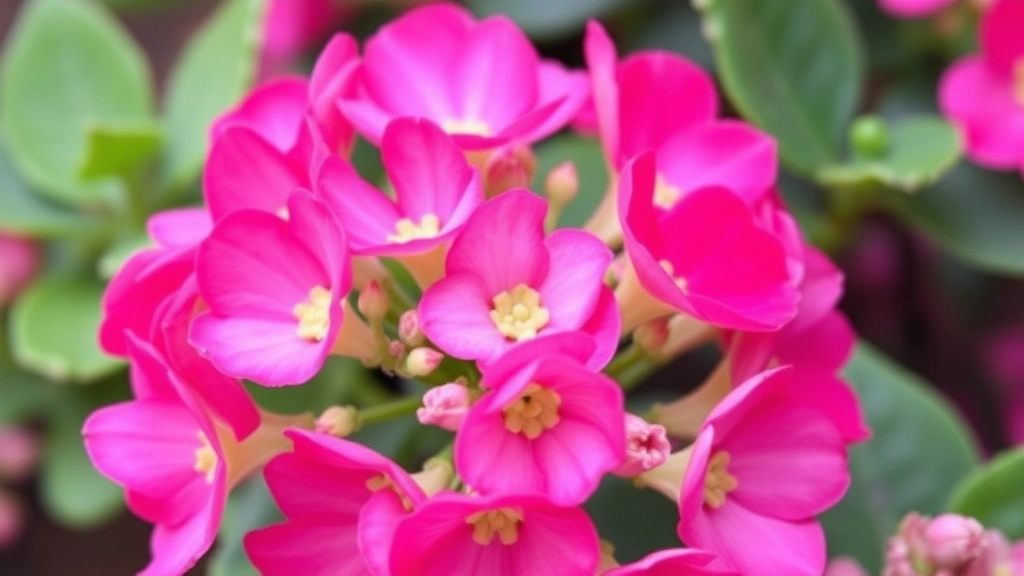
So, you’ve enjoyed those vibrant blooms of your Kalanchoe, but now you’re wondering how to get it to flower again. It’s a common concern for many plant lovers, and the good news is that with a bit of care, you can coax those gorgeous flowers back to life.
Here are some straightforward tips to encourage reblooming:
- Light Exposure: Ensure your Kalanchoe is getting plenty of bright, indirect sunlight. If it’s not getting enough light, it might just sulk and refuse to bloom.
- Pruning: After the blooming period, don’t hesitate to prune back the spent flowers and any leggy growth. This helps redirect the plant’s energy into new blooms.
- Watering Schedule: Allow the soil to dry out between waterings. Overwatering can lead to root rot, which definitely puts a damper on blooming.
- Temperature Control: Kalanchoe prefers warmer temperatures, ideally between 20-25°C during the day and slightly cooler at night. Keeping it cozy can stimulate flowering.
- Fertilization: Use a balanced, water-soluble fertiliser every few weeks during the growing season. This gives your plant the nutrients it needs to produce those lovely flowers.
- Rest Period: After blooming, give your Kalanchoe a rest period of about six weeks. Reduce watering and keep it in a cooler spot. This downtime can help reset the plant for another round of blooms.
- Day Length: Kalanchoe is a short-day plant, meaning it needs longer nights to trigger blooming. If your plant is indoors, consider placing it in a dark area for about 14 hours a day for a few weeks.
By following these tips, you’ll be well on your way to enjoying another stunning display of flowers from your Kalanchoe.
Propagating Kalanchoe Through Stem Cuttings and Offsets
As we explore the journey of caring for your Kalanchoe, understanding how to propagate this resilient plant can be both rewarding and practical.
Many enthusiasts wonder how to expand their collection without breaking the bank.
Propagation Methods:
- Stem Cuttings:
- Select a healthy stem from your Kalanchoe.
- Using clean, sharp scissors, cut a section about 4-6 inches long.
- Allow the cutting to dry for a few hours to form a callus on the cut end.
- Place the cutting in well-draining soil, ensuring it’s upright.
- Water sparingly until roots develop, which can take a few weeks.
- Offsets:
- Look for small plantlets or offsets at the base of your Kalanchoe.
- Gently twist or cut the offset away from the main plant.
- Let it dry for a day to form a callus.
- Plant it in a suitable soil mix, keeping it moist but not soggy.
Tips for Success:
- Always use sterile tools to prevent disease.
- Choose a well-draining soil mix to encourage healthy root growth.
- Keep the newly propagated plants in indirect light until they establish.
Propagation not only allows you to grow more Kalanchoe but also fosters a deeper connection with your plants. For more detailed guidance, check out our step-by-step guide on propagating Kalanchoe Tomentosa and our guide on propagating Kalanchoe Blossfeldiana cuttings.
Common Pests and Diseases to Watch For
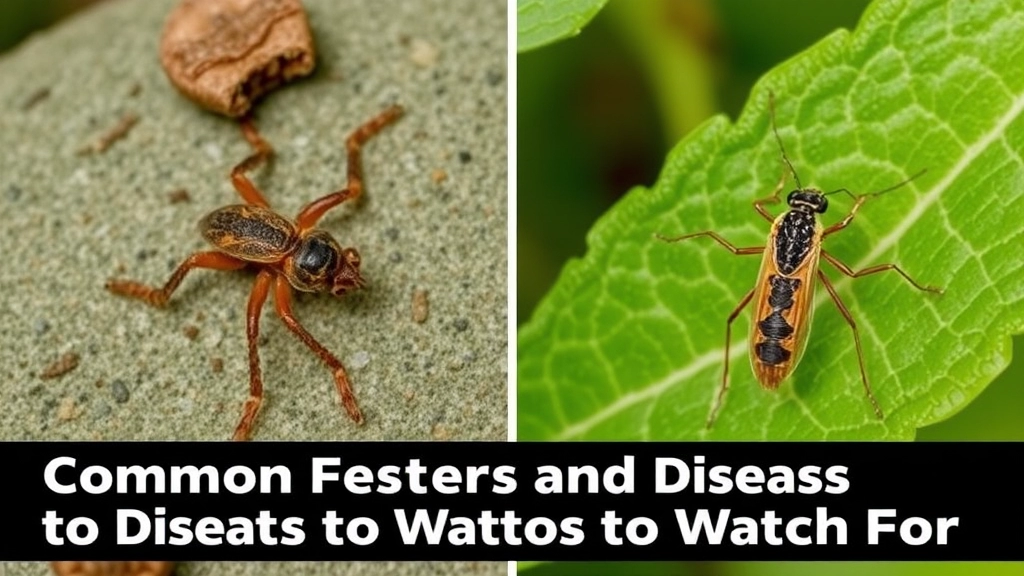
So, you’ve got your Kalanchoe Red thriving, but what about those pesky little critters and sneaky diseases that can ruin your hard work?
Let’s dive into the common pests and diseases that can affect your beautiful Kalanchoe Blossfeldiana.
Common Pests
- Mealybugs
- These little white fluff balls love to hide in the leaf joints.
- They suck the sap, leading to yellowing leaves.
- A simple solution? Wipe them off with a cotton swab dipped in rubbing alcohol.
- Aphids
- Tiny and green, these guys can be hard to spot.
- They can cause stunted growth and curled leaves.
- Spray them with a mild soap solution to keep them at bay.
- Spider Mites
- Look for tiny webs on your plant.
- They thrive in dry conditions.
- Increase humidity around your plant and use insecticidal soap to tackle them.
Common Diseases
- Root Rot
- Overwatering is the main culprit here.
- Watch for yellowing leaves and mushy stems.
- Ensure your pot has good drainage and let the soil dry out between waterings.
- Powdery Mildew
- This white, powdery substance can appear on leaves.
- It thrives in humid conditions.
- Improve air circulation and remove affected leaves to prevent its spread.
- Leaf Spot
- Brown or black spots on leaves can signal this issue.
- Often caused by overwatering or poor air circulation.
- Remove affected leaves and adjust your watering routine.
Prevention Tips
- Regular Checks: Make it a habit to inspect your Kalanchoe weekly.
- Cleanliness: Keep the area around your plant tidy to reduce pest attraction.
- Healthy Soil: Use well-draining soil to prevent root issues.
Pruning and Maintenance for Healthy Growth
As we delve into the care of Kalanchoe, it’s essential to focus on pruning and maintenance. This step not only enhances the plant’s appearance but also promotes healthier growth.
Why Pruning Matters
Pruning is crucial for Kalanchoe Red, as it helps to:
- Remove Dead or Dying Leaves: This prevents the spread of disease and keeps the plant looking vibrant.
- Encourage New Growth: Cutting back old stems encourages the plant to produce fresh, healthy shoots.
- Maintain Shape: Regular trimming helps to keep the plant bushy and compact, rather than leggy.
When to Prune
Timing is everything. The best time to prune your Kalanchoe is:
- After Flowering: Once the blooms have faded, this is the ideal moment to tidy up the plant.
- In Spring: Early spring is another great time to give your Kalanchoe a good trim as it prepares for the growing season.
Pruning Techniques
Here are some simple techniques to follow:
- Use Clean, Sharp Tools: This minimizes the risk of infection.
- Cut Above a Leaf Node: This encourages new growth from the cut area.
- Remove Only a Third: Avoid cutting too much; a third of the plant is a safe limit.
Maintenance Tips
In addition to pruning, regular maintenance is key:
- Check for Pests: Regularly inspect your Kalanchoe for any signs of pests like mealybugs or aphids.
- Dust Leaves: Gently wipe the leaves with a damp cloth to keep them clean and allow for better light absorption.
- Repot as Needed: If your plant outgrows its pot, consider repotting to provide more space for roots.
For a more detailed guide on keeping your Kalanchoe thriving, check out our Florist Kalanchoe Pruning Guide. Additionally, if you’re interested in learning about the various Kalanchoe Varieties with Pink Edges, we have a comprehensive list for you.
FAQs about Florist Kalanchoe Red
What light conditions are best for Florist Kalanchoe Red?
Florist Kalanchoe Red thrives in bright, indirect sunlight. Aim for about 6 hours of such light daily. If the light is too harsh, use sheer curtains to filter it.
How do I know if my Kalanchoe is getting too much or too little light?
If your Kalanchoe starts stretching or looking leggy, it’s a sign of insufficient light. Yellowing leaves or burnt tips indicate too much light.
What is the ideal temperature range for Kalanchoe Blossfeldiana?
Kalanchoe prefers temperatures between 18°C to 24°C (65°F to 75°F) during the day and slightly cooler at night, around 15°C to 18°C (59°F to 65°F).
What temperature extremes should I avoid for my Kalanchoe?
Avoid exposing your plant to cold drafts and heat sources like radiators or heating vents, as these can stress the plant.
How can I encourage my Kalanchoe to rebloom?
To encourage reblooming, ensure your Kalanchoe gets plenty of bright, indirect sunlight, prune spent flowers, allow the soil to dry between waterings, maintain warm temperatures, fertilize during the growing season, and provide a rest period with reduced watering.
What common pests should I watch out for with Kalanchoe Red?
Common pests include mealybugs, aphids, and spider mites. Regularly inspect your plant and use appropriate treatments like rubbing alcohol for mealybugs, mild soap solutions for aphids, and insecticidal soap for spider mites.
What diseases commonly affect Kalanchoe, and how can I prevent them?
Common diseases include root rot, powdery mildew, and leaf spot. Prevent these by avoiding overwatering, ensuring good air circulation, and using well-draining soil.
How can I prevent pests and diseases in my Kalanchoe?
Regularly check your plant, keep the area around it clean, and use healthy, well-draining soil to reduce the risk of pests and diseases.
References
-
How to Grow and Care for Kalanchoe
-
Kalanchoe Plant Care
-
Kalanchoe: How to Grow and Care for Kalanchoe Plants
